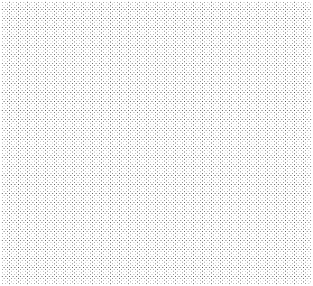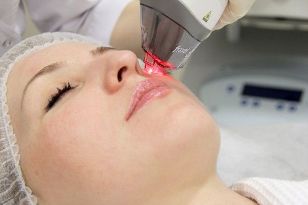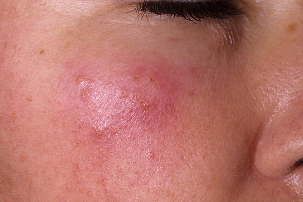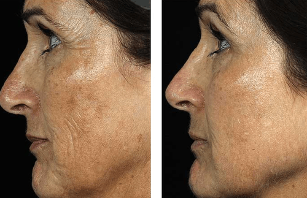Fraxel laser resurfacing can solve many skin problems. The technology has already become widespread, almost displacing other laser equipment for anti-aging procedures from the market. The secret of such popularity is that the fractional laser is safer than the conventional one.
What is Fraxel laser resurfacing?

Fraxel technology was developed in the USA in 2004. At that time, the possibility of resurfacing using laser light was already known. But the developers of the new method went further: they changed the structure of the laser beam. Instead of a narrowly directed beam of light, several hundred microbeams of different lengths were applied to the skin at once.A conventional laser heats the entire illuminated area, the fractional laser acts pointedly, burning the channels of the stem in the skin no more than 0. 1mm wide and 0. 4 to 1. 9mm deep.For 1 cm2of skin, there can be up to several thousand such fractions: damaged areas alternate with intact ones. In the language of cosmetologists, the areas that have been exposed to radiation are called microthermal treatment zones.
Unlike other stump technology lasers, Fraxel shines uniformly across all micro-areas of the skin at a distance of hundredths of a millimeter.
There are several fractional rejuvenation techniques, because manufacturers have taken into account that people age differently - each type of aging has its own specific age-related changes. As a source, the technology developers took two types of lasers: erbium and thulium.
The erbium laser acts on the upper layers of the epidermis, more precisely, on its lipid layer, in which water molecules accumulate and retain them, which are the ones that absorb light energy. Under the influence of high temperatures, the water evaporates and the dead cells that form the upper layer of the skin are burned with a laser. Such an aggressive effect immediately provokes a protective reaction of the body - increased metabolism, so that damaged areas of the skin are restored as quickly as possible. On average, it takes 1 to 2 weeks for microtrauma to heal and 3 to 4 months for a full recovery. The procedure is called ablation or ablative rejuvenation. The skin then becomes cleaner and clearer, pigmentation spots and keratomas disappear, fine wrinkles are erased. The first generation apparatus with a wavelength of 1550 nm (superficially penetrated, down to 20-50 microns or 0. 02-0. 05 mm) operated with an erbium laser. Then it became clear that an even gentler technology was needed, for the treatment of fine and sensitive skin in the eye / lip area. The wavelength was reduced to 1420 nm.
The 1927 nm wavelength thulium laser is designed to heat the upper layers of the dermis, where the collagen-elastin mesh is located. The protein fibers, of which it is composed, change their structure by thermal action: they fold and condense. If you visualize them: they look like springs, but with age due to active facial expressions and under the influence of gravity, they lose their elasticity and straighten. With the weakening of the collagen structure, the dermis first loses its tone, then sags and accumulates in folds and the upper layer of the skin and wrinkles appear. So, due to the high temperature, again, as it were, they fold into springs and over time lift the flabby tissue behind them. In this way, some wrinkles, including deep ones, are smoothed out. The thulium laser is not used separately for fractional resurfacing. But its energy is effectively combined with that of an erbium laser.
By combining two types of exposure, laser equipment manufacturers have received the device: the gold standard of anti-aging cosmetology.
Fraxel laser irradiation works on all layers of the skin, helping to solve a variety of age-related problems.
With the advent of high-powered CO2 lasers, rejuvenating treatments have become even more effective. The light pulses in them are amplified due to the fact that they pass through the carbon dioxide molecules. This technology is used by a laser, in which, in addition to erbium, ablative rejuvenation is performed. But the energy of the CO2laser penetrates much deeper, down to 300 microns or 0. 3 mm. The technology allows you to achieve a visible improvement in the quality and texture of the skin: improve the complexion, reduce pores, eliminate scars and stretch marks, smooth wrinkles. A dermal optical thermolysis procedure is also performed using a carbon dioxide laser, when the radiation affects even deeper layers of the skin.
For fractional laser resurfacing
Fractional laser resurfacing is more in demand among women, although men sometimes use it as well. The average age of patients is 30 to 50 years, plus or minus five years up to the lower and upper limits. In fact, there are no strict age restrictions, whether it is worth doing resurfacing with a fractional laser, determines a dermatologist-cosmetologist at a preliminary examination. It's just that at a younger age the metabolism is already quite active, there are still no visible age-related changes, and you can work with problem skin with other gentler methods. After 50 years, fractional rejuvenation, on the contrary, may no longer give a noticeable result, because the tissues are deformed quite strongly, superficial correction will give a short-term result, and perhaps not at all.
When applying laser resurfacing:

- with enlarged pores and post-acne traces;
- with sickly paleness, poor complexion;
- for fine superficial wrinkles;
- for hyperpigmentation and freckles;
- for scars and stretch marks.
Fractional thermolysis is indicated for wrinkles, folds and folds on the face, neck, décolleté, loss of tone and sagging skin.
Women say that after Fraxel their skin looks younger than its age for 3-5 years, although this is not the case for all.
Contraindications to the procedure
Any procedure that uses a fractional laser is contraindicated:
- patients under 18 years of age;
- pregnant and lactating women;
- cancer patients;
- people with heart and vascular diseases;
- diabetics;
- allergy sufferers (the doctor should be warned about allergies to the laser itself or to anesthetic drugs).
It is not recommended to be exposed to the action of the laser if the skin in the area of the procedure is injured, inflamed or covered with a rash, with herpes, dermatitis, psoriasis. The procedure can only aggravate existing problems, so the skin must be healthy.Relative contraindications for laser rejuvenation / thermolysis: chemical peel or facelift performed the previous month. The possibility of fractional rejuvenation in such cases should be consulted with a physician.
Differences of fractional laser procedure from other types
The possibility of rejuvenation in a fractional laser was discovered when similar procedures were carried out on other lasers: thermolysis was performed on diode and neodymium lasers, the deep layers of the skin were heated, in erbium and carbon dioxide witha long wavelength, a total laser resurfacing was performed. The result was both from one procedure and the other, but he had to wait too long. After polishing, surface treatment, the skin recovered for a month and a half; not all patients were satisfied with this period. Also, the risk of side effects remained high. When the metered supply of light energy became possible, salons began to massively switch to new technologies: the fractional laser began to be used everywhere.
Even after a procedure, significant tissue changes occur, but to consolidate the result, you need to go to the beautician 3-4 times.
There are also new procedures:
- charcoal stripping. The top layer of the skin is treated with a carbon (charcoal) gel and then laser irradiation is applied to it to heat the deep layers of the dermis. The mechanism of action, in general, is standard: regeneration occurs more intensively from high temperatures. But thanks to the laser, the gel also penetrates deep enough: so that even after one session, the pores are cleaned, the work of the sebaceous glands normalizes, the face becomes cleaner and smoother. The procedure is recommended for patients with oily skin;
- Laser biorevitalization is a procedure that has replaced the injection technique. Gel with hyaluronic acid is applied to the problem area, then the skin is treated with a laser, usually diode. With the discovery of lasers, it became clear that even external agents can penetrate deeper, which means that they can work more efficiently if, after application, the desired area is treated with laser light. This also happens with hyaluronic acid molecules: if in an ordinary cream or gel they are absorbed only superficially and washed off after the first facial cleansing, after the laser they fall into the deep layers of the epidermis, where all the necessary moisture accumulatesfor the skin.
What are the advantages and disadvantages of the laser procedure? - table
| Pros | Cons |
|
|
How to prepare for the procedure
Preparation for fractional rejuvenation begins with a consultation with a dermatologist. After the examination, you must give the green light to the procedure and personal recommendations. The restrictions generally refer to:
- lifestyle. 3-4 weeks before the procedure, you should refuse to visit the solarium, and before going out, use a cream with an SPF filter;
- taking certain medications: antibiotics, blood-thinning medications taken by almost one in two women over 30 years old. But drinking drugs for herpes, on the contrary, is worth it;
- cosmetic procedures. 2 weeks before the procedure, it is recommended not to perform any other procedures to cleanse and rejuvenate the face, it is better to abandon even the home peeling, so as not to damage the skin once again, and switch to gentle care.

You must come to the salon without makeup.
The day before and on the day of the session, it is recommended not to drink too much, so that there is no tissue edema.
If there is a tendency to herpes, it is recommended to drink antiviral medications during preparation for the procedure.
How the procedure is performed in the salon
Procedure for the procedure:
- The first thing a doctor does is disinfect the skin and apply anesthetic. The application of anesthesia is usually sufficient.
- Next, a contact gel is applied, which is necessary for the laser handle to glide more easily on the skin.
- The nozzles are of different diameters: 7x7 mm or 15x15 mm. During an activation, 1–2 cm2of the skin glows, so the session takes very little time. It takes about half an hour to treat the face and neck, and about 10 minutes for the hands.
- Unpleasant sensations usually arise not during the procedure, but later, when the anesthesia begins to subside. When the skin is illuminated with a laser, it feels hot, burning and tingling, but tolerable; because the burn of the micro-areas is easier to perceive than if a directed ray burned the upper layer of the skin centimeter by centimeter.
What effect will it have after the procedure and when will it appear?
On the second or third day after the procedure, when the edema disappears, a light matte tan will appear on the skin, the tone will become softer and the complexion will be refreshed. It takes time for the skin to recover, about a month. After this time, a lifting effect will be noticed, an improvement in the quality of the skin, that is, an increase in its density, elasticity, a decrease in pores, a lightening of age spots.To consolidate the result, you need to perform 3-4 procedures at intervals of a month.After another 3-4 months, when the collagen-elastin structure is restored, the face will become even tighter, the wrinkles will disappear, the face will look 5 years younger or even more. If all the doctor's recommendations are followed, this condition can be maintained for several years. In salons, they avoid making accurate predictions, because no anti-aging procedure overrides the laws of aging.

Judging by reviews, the result can last up to 3-5 years. It is unlikely to last longer: irreversible age-related changes can only be slowed down, but then they will reappear and the course of treatment will need to be repeated.
Patient before and after fractional rejuvenation - photo
What complications can they be and how to avoid them
Complications are possible even if the doctor fully observes the procedure. Whether they are or not depends on the patient's health status and the individual's reaction to the procedure. The responsibility for carrying out fractional rejuvenation in the presence of contraindications rests with the patient, if he was aware of them, but did not warn the doctor or withhold important information from him about the diseases suffered, the procedures performed and the allergy to drugs.
Almost 15 years of practice have shown that after fractional rejuvenation there can be side effects such as:
- acne;
- herpes;
- age spots;
- persistent redness of the skin (erythema);
- persistent tissue edema.
There were no cases of scars and keloid tumors.
Rehabilitation period
Immediately after the procedure, patients experience severe tissue pain and swelling. It will be easier if you regularly apply an ice pack (ice cubes wrapped in a napkin or towel or a bottle of frozen water) to the treated skin area every 3-4 hours. You can go outside / work the next day, but it will be better to wait at home 2-3 days, making compresses and lubricating the skin with a tissue regeneration stimulator. No physical activity, sunbathing, or even a hot shower. Rest, warm shower, cream and compresses, for at least 2 days.
Then the skin will heal: first dry scabs form, then they will start to peel off and fall off.It is not necessary to touch them, much less tear them off.Alcohol-based cosmetics (lotions, toners) for the recovery period should be discarded. Decorative cosmetics are allowed 2-3 days after the procedure.
Fractional Laser Skin Rejuvenation Reviews
"Before the procedure itself, an anesthetic ointment is applied. The ointments are also different. I had the effect of relieving pain in 15 minutes. The procedure itself continues. The doctor showed me the effect of the laserfirst on a sheet of paper. The holes are burned at a distance of 1 mm from each other. Then they burned me . . . The procedure lasted 15 minutes: face and neck. It is unpleasant, but quite tolerable. Problems begin when the effect endsof anesthetic ointment. This is an elemental burn, and the consequences are the same as for a burn. The whole face is reddened, swollen, burned. Therefore, it is recommended that the procedure be performed on Friday night. The doctor gave the following instructions: smear abundantly and often with ointment for burns. First, it is better to use an ointment that contains a cooling component. Also more often moisten the face with cold water. Severe growth disappeared somewhere on Saturday night (in one day, a lot of brown crusts formed on the burned places, but the procedure is good because on the second day you can use decorative cosmetics. oh and cover it all up. On the third day at night you need to bathe or go to the bathhouse. Steam your face with your fingertips to remove the scabs. Don't use a scrub! The effect grows gradually. After the first procedure, the oval of the face was squeezed, the vessels around the nose disappeared. To get the full effect, the doctor prescribed 4 procedures with one break per month. Note that Fraxel is easier on brunettes as it is similar to sunburn. "
"I did DOT laser resurfacing. Day 1. The procedure is painful. I was anesthetized for an hour. But it still hurts. It smells like burned meat. Immediately after the procedure, the appearance is normal, just puffy eyes. The faceit hurts for 2-3 hours. at night begins, how to put it mildly, swelling . . . the look of a three season homeless woman. Day 2. In the morning there is horror! There is no pain. But the look of aTajik and a man. The skin darkens. The eyes narrow. The face is very swollen. At night, the eyes gradually open. Herpes 2 crawled down the lower lip. The doctor warned me that if herpes lives on thebody, it will definitely come out. So it came out. Beauty is impossible. . . Day 3. No pain. Swelling slowly disappears. Scab on face. Scary. 4th day. Scab begins to fade gradually. No pain. The face is strange, but not terrible. 5th day. rende. The face is pink, as after a severe sunburn. The skin is like that of a baby. He eats everything that cannot be offered in huge, All creams, all masks under the broom. Healed lips. On the ninth day - a feast for the eyes! Testing myself in the mirror, I can't see enoughTurgor is completely different. Under the eyes (my most painful point) everything is smooth. Not a single wrinkle. I don't know what will happen next. But for today, the tenth day, I am VERY happy. "
"I was lucky enough to become the owner of the most difficult scars to treat on the face. Namely, chips and boxes. If anyone does not know, these scars are characterized by sharp and uneven edges. 4 years ago I startedthis epic with her treatment. I knew the variety of different methods and succumbed to the doctor's persuasion to do a fractional laser resurfacing on the Dot device. By the way, the doctor promised to make me a perfectly smooth face in 3 procedures. Intellectually I understood that thisit was impossible. After all, I have complex scars. But hope burned in me. The day of the first procedure came. Oh God! It was excruciatingly painful! The smell of burning skin was still ending. At home, I had to sit withoutgoing out for about a week, smearing my face incessantly with a tissue regeneration stimulator, and being afraid of my reflection in the mirror, because they showed Krugger disguised as a womanAfter 6-7 days, I already took the risk of going out with people. The redness subsided, but the scars were in place. To my surprise, my whole face turned into a small hole. They were laser marks. That is what I did not expect! They promised perfect smoothness. And in the end, they added irregularities. "Well, okay, " I thought, and went to the second procedure. And then in the third. Personally, my eyes dazzle with such softness. In my opinion, nothing has changed! The grid-shaped prints from the laser, by the way, are still with me. They are not flashy, but if you look closely, you can see them. I sneak them out with ultrasonic massage, mesoscooter and peels. And in Dot, I am no longer a foot! It's absolutely ridiculous for my scarred type! "
Fractional rejuvenation certainly has many benefits. But there are negative reviews from patients, there are cases when even one procedure caused health problems in people. This happened for various reasons, often due to contraindications to laser resurfacing in principle. To protect yourself from possible negativity after the procedure, play it safe before: go to the doctor, get tested, listen to not one, but several cosmetologists. Still, safety and health are inseparable.







































